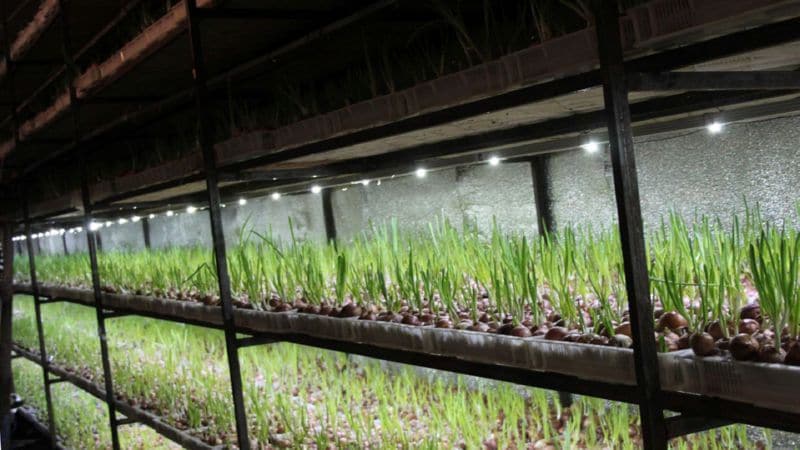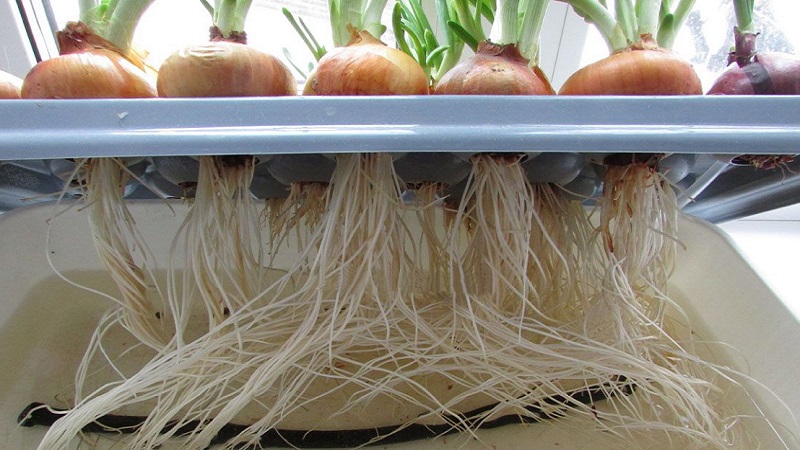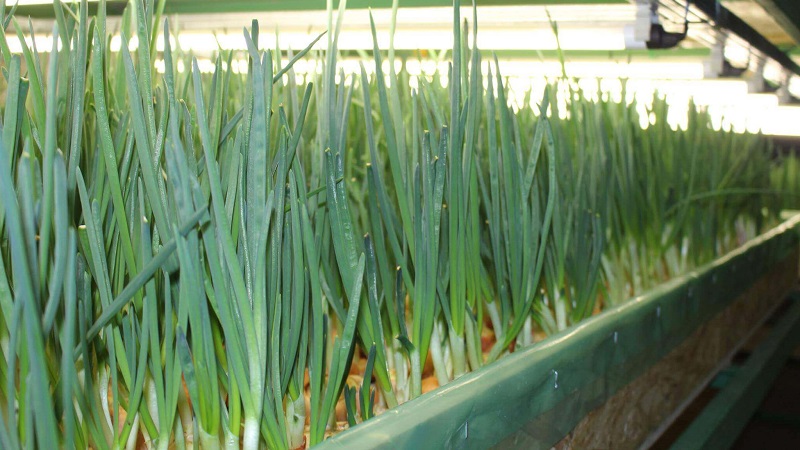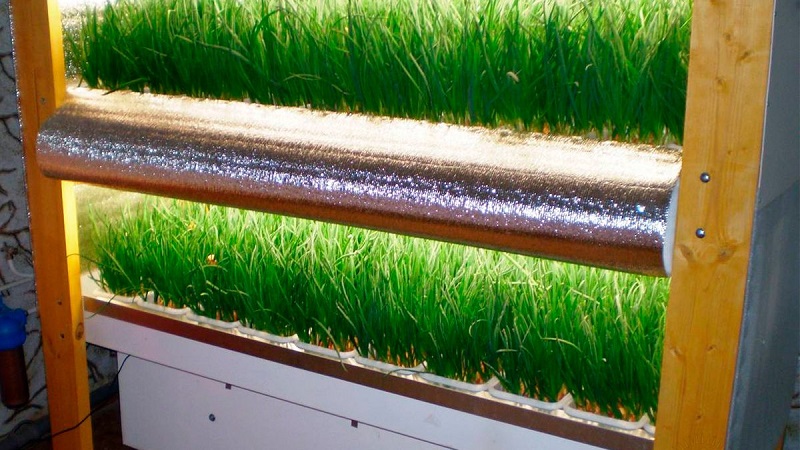A beginner's guide to growing green onions in the basement
Green onion feathers contain a wealth of health-promoting compounds. IN winter time the use of vitamin greens eliminates vitamin deficiency. If there is a basement, onions can easily be grown there on shelves, even in winter. It is enough to create the necessary conditions for forcing feathers, to provide additional heating of the room. For details on how to grow onions in the basement, read on.
The content of the article
Is it possible to grow green onions in the basement
When growing vitamin vegetables use extremely simple technology. It is important to create suitable conditions: to provide sufficient lighting, temperature and constant air circulation.

The advantages and disadvantages of this method
Advantages of growing crops in the basement:
- getting a green feather regardless of the season;
- forcing a large amount of onions;
- leaving does not depend on external weather conditions;
- ease of growing;
- the possibility of growing in all regions of the country.
The disadvantage of growing in winter is the cost of lighting and heating the room.
Room requirements
The room for the high-quality growth of onions should be equipped with air heating and ventilation systems, equipped with sufficient lighting. The required temperature regime must be observed in the room. The basement must be dry and clean.
Before installing the shelving, the walls are recommended to be disinfected with copper sulfate. The drug is dissolved in water in a ratio of 120-150 g per 1 liter. The resulting composition is used to process walls, ceilings, shelves. If the floor is earthen, it is watered with the composition, the liquid is allowed to be absorbed. After processing, the room is ventilated so that all surfaces dry well.

Rack equipment
The design of the racks allows you to plant crops in several tiers and significantly save space. And it is convenient to attach fluorescent lamps to its shelves.
The dimensions of the rack should be such that there is space between it and the walls of the basement for movement while caring for the crop. If the size of the room allows you to install several racks, about 1 m is left between them.The height between the shelves is 55-60 cm.
The rack can be made independently from wood and self-tapping screws. This will require a minimum of cash investment.
Attention! The disadvantage of wooden shelving is the appearance of mold and fungi in humid conditions. The tree rots quickly.
More reliable and durable - metal structures. To prevent corrosion, paint must first be applied to the rack. If you make side bumpers with a height of 9-12 cm on each shelf, the growing boxes are ready. A dense plastic wrap is laid out on the shelves, wrapping it over the edges of the sides. Then the ground mixture is poured onto the film. Often, wooden or plastic boxes with a substrate are simply installed on the shelves.

Lighting and ventilation
Lighting plays an important role in growing green feathers. For this, fluorescent lamps or phytolamps are attached to the shelves. Conventional incandescent lamps are not used - they heat the air over the onion plantings. Backlighting is not needed immediately, but when the first shoots appear.
Daylight hours when forcing onions should be 13-15 hours. With a lack of light, feathers will grow thin, weak and pale.The lamps are mounted over the plants, allowing the greenery to grow straight up, gaining strength.
The basement is equipped with a ventilation system. Fans are used for constant air circulation. Additionally, they provide a periodic flow of fresh air from the street. These measures will prevent the growth of mold and mildew on the shelves.
How to grow green onions in your basement
Growing process green onions in the basement is easy.
Training
Before planting, the planting material is selected. Rotten, damaged heads are not suitable for germination, they will immediately rot. For planting, choose healthy, strong heads with dry shiny scales, medium size.
It is best to germinate bulbs with a diameter of 4-5 cm. Before planting, the selected material is heated for two days at a temperature of +35 .. + 38 ° C. Then the neck is cut off at the heads to a depth of 0.7-1 cm, this stimulates the awakening of the sleeping points of feather growth. After that, the bulbs are soaked for 2-4 hours in a pink solution of potassium permanganate for disinfection.
Important! An important factor for obtaining a high yield is the selection of bulbs with not one, but with 2-3 “buds”. From one point of growth, the yield of green mass will be insignificant.
Landing
For growing crops, use a ready-made substrate or make a mixture of 4 parts of garden soil, 1 part of sand, 1 part of peat. The root system of the onion is fibrous, has many thin filamentous roots. No deep container is required for germination. It is enough to fill the shelves of the rack with sides with prepared soil in a layer of 5-7 cm.
The heads are planted at a distance of 2 cm from each other. They are not buried completely, but only to half the size of the head. You cannot deepen the cut off top - the process of its rotting will begin in the soil. After planting, the soil is slightly moistened.
Care

For fast feather growth, adhere to the recommended temperature regime. During the first week, the air temperature should be within +13 .. + 15 ° С. This is essential for the growth of a healthy root system. After that, the temperature is maintained at +22 .. + 25 ° С. With a lack of heat, the growth of greenery will slow down.
To obtain strong, juicy feathers, top dressing is carried out. Before planting, nitrogen, phosphorus, potassium are introduced into the soil in the form of a solution: 25 g of superphosphate, 30 g of urea, 20 g of potassium nitrate per 10 liters of water. The second feeding is carried out 14 days after the emergence of shoots: 100 g of chicken droppings are infused for two days in 10 liters of water, then the soil is watered between shoots.
Important! They feed only on moist soil.
Fertilization with wood ash gives excellent results - it prevents the formation of mold and fungi. Ash is scattered around the bulbs or an aqueous solution is prepared for irrigation.
Pour water at room temperature under the root, while making sure that water does not get on the green feathers. Watering should not be abundant, as this will cause rotting of the heads. A week before cutting the feathers, watering is stopped so that the greens are not watery.
Potential problems, diseases and pests
In insufficient light, seedlings will grow thin, pale. Lower temperatures will slow down feather growth. Do not allow moisture to enter the growth points, this will lead to rotting of the plant. Drafts have a detrimental effect on green plantings.
Chives are often affected by diseases such as powdery mildew and rust.
Rust - a fungal disease that occurs in conditions of excessive watering, an excess of nitrogen fertilizers. Small yellow growths appear on the feathers. The disease causes feathers to dry out. To eliminate the disease, the soil is watered with a medicinal composition: an aspirin tablet, 5 ml of liquid soap, 10 g of baking soda are diluted in 5 liters of water. In case of severe lesions, biological preparations "Fitosporin", "Baktofit" are used.
Powdery mildew - fungal infection, appears with high humidity, lack of ventilation. It is characterized by the appearance of a yellowish bloom on the leaves.The disease leads to drying out of the leaves, the death of the crop. Milk whey is used as a safe treatment method: 1 part of whey is diluted with 2 parts of water, and the affected plants are sprayed. The soil is watered with a solution of wood ash (200 g of ash per 10 liters of water).
Frequent pests of green onions:
- Onion fly - makes clutches of eggs inside the bulb. The larvae feed on the pulp, as a result of which the onion withers and rots. When an insect appears, tobacco dust is used, which is sprinkled between plants or watered with a solution: 250 g of tobacco dust and 10 liters of water are infused for 24 hours.
- Thrips feed on the sap of green feathers, this leads to the drying of the leaves. To destroy insects, the room is fumigated with sulfur. The soil is shed by "Fitoverm", "Spintor". Sticky traps are laid out between the rows: glue for catching flies is applied to yellow, blue cardboard boxes.

Harvesting
Under the correct growing conditions, the green mass reaches a height of 35-40 cm within 20-30 days. After the feathers reach a height of 40 cm, harvesting begins.
Green feathers are cut with a clean sharp knife, collected in bunches of 50-70 g. The bunches are tied with clerical rubber or wrapped in cling film. Then they are placed on storage.
Is it possible to make it a business
Growing green onions all year round, especially in winter, is a profitable business, since the cost of greens in winter is high, and the costs are low. With the accumulation of sufficient experience, you can organize your business, gradually increasing profits.
The business does not require large investments and special skills in caring for the culture. Vitamin products are in great demand all year round. It is only important to choose and plant the onion correctly, carefully care for the plantings, preventing disease.
Environmentally friendly products can be taken to grocery stores, canteens. If desired, independently sell on the markets. Consider the increased demand for greens before various holidays - this is a great chance to multiply your profits.
Profitability
Gardeners have calculated that the cost of green onions grown in a basement is 45-50 rubles / kg. In supermarkets, on the market, the price of green products in winter is in the range of 130-180 rubles.
When grown by the bridge method on racks with a consumption of onions in the amount of 10 kg, the yield of green feathers is 8.5 kg. This is an excellent result, since the cost of greens is 2.5-3.5 times higher than the cost of onions.
Tips & Tricks
To save space when planting, onions are planted using a bridge method. The heads are planted in rows tightly to each other. This method allows you to get more crops in a small area for cultivation.
Lighting efficiency is enhanced with reflective surfaces. To do this, the shelves, walls, sides of the shelves are covered with foil.
For growing feathers use varietiescapable of forming an increased number of primordia.
These varieties include: Karatalsky, Rostov local, Stuttgart, Chalcedony.
Conclusion
Green onions are an unpretentious and sought-after culture. Growing it in the basement in winter is not difficult.
Observing the recommended agricultural practices when caring for green beds, you will definitely achieve high yields. And then in winter there will always be juicy, healthy, vitamin greens on the table.